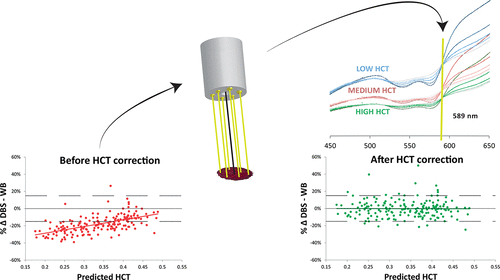当前位置:
X-MOL 学术
›
Anal. Chem.
›
论文详情
Our official English website, www.x-mol.net, welcomes your feedback! (Note: you will need to create a separate account there.)
Correction for the Hematocrit Bias in Dried Blood Spot Analysis Using a Nondestructive, Single-Wavelength Reflectance-Based Hematocrit Prediction Method
Analytical Chemistry ( IF 7.4 ) Pub Date : 2018-01-17 00:00:00 , DOI: 10.1021/acs.analchem.7b03784 Sara Capiau 1 , Leah S. Wilk 2 , Pieter M. M. De Kesel 1 , Maurice C. G. Aalders 2 , Christophe P. Stove 1
Analytical Chemistry ( IF 7.4 ) Pub Date : 2018-01-17 00:00:00 , DOI: 10.1021/acs.analchem.7b03784 Sara Capiau 1 , Leah S. Wilk 2 , Pieter M. M. De Kesel 1 , Maurice C. G. Aalders 2 , Christophe P. Stove 1
Affiliation

|
The hematocrit (Hct) effect is one of the most important hurdles currently preventing more widespread implementation of quantitative dried blood spot (DBS) analysis in a routine context. Indeed, the Hct may affect both the accuracy of DBS methods as well as the interpretation of DBS-based results. We previously developed a method to determine the Hct of a DBS based on its hemoglobin content using noncontact diffuse reflectance spectroscopy. Despite the ease with which the analysis can be performed (i.e., mere scanning of the DBS) and the good results that were obtained, the method did require a complicated algorithm to derive the total hemoglobin content from the DBS’s reflectance spectrum. As the total hemoglobin was calculated as the sum of oxyhemoglobin, methemoglobin, and hemichrome, the three main hemoglobin derivatives formed in DBS upon aging, the reflectance spectrum needed to be unmixed to determine the quantity of each of these derivatives. We now simplified the method by only using the reflectance at a single wavelength, located at a quasi-isosbestic point in the reflectance curve. At this wavelength, assuming 1-to-1 stoichiometry of the aging reaction, the reflectance is insensitive to the hemoglobin degradation and only scales with the total amount of hemoglobin and, hence, the Hct. This simplified method was successfully validated. At each quality control level as well as at the limits of quantitation (i.e., 0.20 and 0.67) bias, intra- and interday imprecision were within 10%. Method reproducibility was excellent based on incurred sample reanalysis and surpassed the reproducibility of the original method. Furthermore, the influence of the volume spotted, the measurement location within the spot, as well as storage time and temperature were evaluated, showing no relevant impact of these parameters. Application to 233 patient samples revealed a good correlation between the Hct determined on whole blood and the predicted Hct determined on venous DBS. The bias obtained with Bland and Altman analysis was −0.015 and the limits of agreement were −0.061 and 0.031, indicating that the simplified, noncontact Hct prediction method even outperforms the original method. In addition, using caffeine as a model compound, it was demonstrated that this simplified Hct prediction method can effectively be used to implement a Hct-dependent correction factor to DBS-based results to alleviate the Hct bias.
中文翻译:

使用非破坏性,基于单波长反射的血细胞比容预测方法对干血斑分析中的血细胞比容偏倚进行校正
血细胞比容(Hct)效应是目前阻止常规情况下更广泛地实施定量干血斑(DBS)分析的最重要障碍之一。实际上,Hct可能会影响DBS方法的准确性以及基于DBS的结果的解释。我们先前开发了一种使用非接触式漫反射光谱法根据血红蛋白含量确定DBS的Hct的方法。尽管可以轻松进行分析(即仅扫描DBS)并获得了良好的结果,但该方法确实需要复杂的算法才能从DBS的反射光谱中得出总血红蛋白含量。由于将总血红蛋白计算为氧合血红蛋白,高铁血红蛋白和半色素的总和,在老化过程中,DBS中会形成三种主要的血红蛋白衍生物,因此需要将反射光谱解开以确定每种衍生物的量。现在,我们仅使用反射率曲线中准等吸收点处的单个波长的反射率简化了该方法。在该波长下,假设老化反应的化学计量为一对一,反射率对血红蛋白降解不敏感,并且仅随血红蛋白总量(因此与Hct)成比例。此简化方法已成功验证。在每个质量控制水平以及定量极限(即0.20和0.67)下,日内和日间不准确性均在10%以内。根据所进行的样品再分析,方法的重现性极佳,并超过了原始方法的重现性。此外,评估了点样量,点内测量位置以及存储时间和温度的影响,没有显示这些参数的相关影响。对233个患者样品的应用显示,在全血中测定的Hct与在静脉DBS上测定的预测Hct之间具有良好的相关性。通过Bland和Altman分析获得的偏差为-0.015,一致极限为-0.061和0.031,这表明简化的非接触式Hct预测方法甚至优于原始方法。此外,使用咖啡因作为模型化合物,证明了这种简化的Hct预测方法可以有效地用于对基于DBS的结果实施Hct依赖性校正因子,以减轻Hct偏差。评估了点内的测量位置以及存储时间和温度,未显示这些参数的相关影响。对233个患者样品的应用显示,在全血中测定的Hct与在静脉DBS上测定的预测Hct之间具有良好的相关性。通过Bland和Altman分析获得的偏差为-0.015,一致极限为-0.061和0.031,这表明简化的非接触式Hct预测方法甚至优于原始方法。此外,使用咖啡因作为模型化合物,证明了这种简化的Hct预测方法可以有效地用于对基于DBS的结果实施Hct依赖性校正因子,以减轻Hct偏差。评估了点内的测量位置以及存储时间和温度,未显示这些参数的相关影响。对233个患者样品的应用显示,在全血中测定的Hct与在静脉DBS上测定的预测Hct之间具有良好的相关性。通过Bland和Altman分析获得的偏差为-0.015,一致极限为-0.061和0.031,这表明简化的非接触式Hct预测方法甚至优于原始方法。此外,使用咖啡因作为模型化合物,证明了这种简化的Hct预测方法可以有效地用于对基于DBS的结果实施Hct依赖性校正因子,以减轻Hct偏差。显示这些参数没有相关影响。对233个患者样品的应用显示,在全血中测定的Hct与在静脉DBS上测定的预测Hct之间具有良好的相关性。通过Bland和Altman分析获得的偏差为-0.015,一致极限为-0.061和0.031,这表明简化的非接触式Hct预测方法甚至优于原始方法。此外,使用咖啡因作为模型化合物,证明了这种简化的Hct预测方法可以有效地用于对基于DBS的结果实施Hct依赖性校正因子,以减轻Hct偏差。显示这些参数没有相关影响。对233个患者样品的应用显示,在全血中测定的Hct与在静脉DBS上测定的预测Hct之间具有良好的相关性。通过Bland和Altman分析获得的偏差为-0.015,一致极限为-0.061和0.031,这表明简化的非接触式Hct预测方法甚至优于原始方法。此外,使用咖啡因作为模型化合物,证明了这种简化的Hct预测方法可以有效地用于对基于DBS的结果实施Hct依赖性校正因子,以减轻Hct偏差。015和一致性极限分别为-0.061和0.031,这表明简化的非接触式Hct预测方法甚至优于原始方法。此外,使用咖啡因作为模型化合物,证明了这种简化的Hct预测方法可以有效地用于对基于DBS的结果实施Hct依赖性校正因子,以减轻Hct偏差。015和一致性极限分别为-0.061和0.031,这表明简化的非接触式Hct预测方法甚至优于原始方法。此外,使用咖啡因作为模型化合物,证明了这种简化的Hct预测方法可以有效地用于对基于DBS的结果实施Hct依赖性校正因子,以减轻Hct偏差。
更新日期:2018-01-17
中文翻译:

使用非破坏性,基于单波长反射的血细胞比容预测方法对干血斑分析中的血细胞比容偏倚进行校正
血细胞比容(Hct)效应是目前阻止常规情况下更广泛地实施定量干血斑(DBS)分析的最重要障碍之一。实际上,Hct可能会影响DBS方法的准确性以及基于DBS的结果的解释。我们先前开发了一种使用非接触式漫反射光谱法根据血红蛋白含量确定DBS的Hct的方法。尽管可以轻松进行分析(即仅扫描DBS)并获得了良好的结果,但该方法确实需要复杂的算法才能从DBS的反射光谱中得出总血红蛋白含量。由于将总血红蛋白计算为氧合血红蛋白,高铁血红蛋白和半色素的总和,在老化过程中,DBS中会形成三种主要的血红蛋白衍生物,因此需要将反射光谱解开以确定每种衍生物的量。现在,我们仅使用反射率曲线中准等吸收点处的单个波长的反射率简化了该方法。在该波长下,假设老化反应的化学计量为一对一,反射率对血红蛋白降解不敏感,并且仅随血红蛋白总量(因此与Hct)成比例。此简化方法已成功验证。在每个质量控制水平以及定量极限(即0.20和0.67)下,日内和日间不准确性均在10%以内。根据所进行的样品再分析,方法的重现性极佳,并超过了原始方法的重现性。此外,评估了点样量,点内测量位置以及存储时间和温度的影响,没有显示这些参数的相关影响。对233个患者样品的应用显示,在全血中测定的Hct与在静脉DBS上测定的预测Hct之间具有良好的相关性。通过Bland和Altman分析获得的偏差为-0.015,一致极限为-0.061和0.031,这表明简化的非接触式Hct预测方法甚至优于原始方法。此外,使用咖啡因作为模型化合物,证明了这种简化的Hct预测方法可以有效地用于对基于DBS的结果实施Hct依赖性校正因子,以减轻Hct偏差。评估了点内的测量位置以及存储时间和温度,未显示这些参数的相关影响。对233个患者样品的应用显示,在全血中测定的Hct与在静脉DBS上测定的预测Hct之间具有良好的相关性。通过Bland和Altman分析获得的偏差为-0.015,一致极限为-0.061和0.031,这表明简化的非接触式Hct预测方法甚至优于原始方法。此外,使用咖啡因作为模型化合物,证明了这种简化的Hct预测方法可以有效地用于对基于DBS的结果实施Hct依赖性校正因子,以减轻Hct偏差。评估了点内的测量位置以及存储时间和温度,未显示这些参数的相关影响。对233个患者样品的应用显示,在全血中测定的Hct与在静脉DBS上测定的预测Hct之间具有良好的相关性。通过Bland和Altman分析获得的偏差为-0.015,一致极限为-0.061和0.031,这表明简化的非接触式Hct预测方法甚至优于原始方法。此外,使用咖啡因作为模型化合物,证明了这种简化的Hct预测方法可以有效地用于对基于DBS的结果实施Hct依赖性校正因子,以减轻Hct偏差。显示这些参数没有相关影响。对233个患者样品的应用显示,在全血中测定的Hct与在静脉DBS上测定的预测Hct之间具有良好的相关性。通过Bland和Altman分析获得的偏差为-0.015,一致极限为-0.061和0.031,这表明简化的非接触式Hct预测方法甚至优于原始方法。此外,使用咖啡因作为模型化合物,证明了这种简化的Hct预测方法可以有效地用于对基于DBS的结果实施Hct依赖性校正因子,以减轻Hct偏差。显示这些参数没有相关影响。对233个患者样品的应用显示,在全血中测定的Hct与在静脉DBS上测定的预测Hct之间具有良好的相关性。通过Bland和Altman分析获得的偏差为-0.015,一致极限为-0.061和0.031,这表明简化的非接触式Hct预测方法甚至优于原始方法。此外,使用咖啡因作为模型化合物,证明了这种简化的Hct预测方法可以有效地用于对基于DBS的结果实施Hct依赖性校正因子,以减轻Hct偏差。015和一致性极限分别为-0.061和0.031,这表明简化的非接触式Hct预测方法甚至优于原始方法。此外,使用咖啡因作为模型化合物,证明了这种简化的Hct预测方法可以有效地用于对基于DBS的结果实施Hct依赖性校正因子,以减轻Hct偏差。015和一致性极限分别为-0.061和0.031,这表明简化的非接触式Hct预测方法甚至优于原始方法。此外,使用咖啡因作为模型化合物,证明了这种简化的Hct预测方法可以有效地用于对基于DBS的结果实施Hct依赖性校正因子,以减轻Hct偏差。



























 京公网安备 11010802027423号
京公网安备 11010802027423号